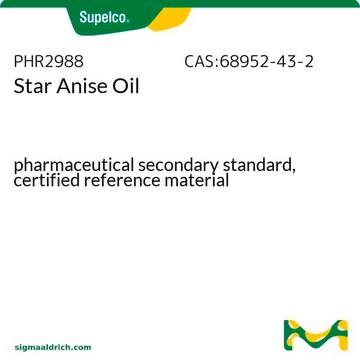All Photos(1)
About This Item
Linear Formula:
(CH3)2CHCH2CO2CH2CH2CH=CHC2H5
CAS Number:
Molecular Weight:
184.28
FEMA Number:
3498
EC Number:
Council of Europe no.:
2344
MDL number:
UNSPSC Code:
12164502
PubChem Substance ID:
Flavis number:
09.505
NACRES:
NA.21
Recommended Products
biological source
synthetic
Quality Level
grade
FG
Halal
Kosher
reg. compliance
EU Regulation 1334/2008 & 178/2002
FCC
Assay
≥97%
refractive index
n20/D 1.432 (lit.)
bp
98 °C/15 mmHg (lit.)
density
0.874 g/mL at 25 °C (lit.)
application(s)
flavors and fragrances
Documentation
see Safety & Documentation for available documents
food allergen
no known allergens
Organoleptic
apple; green
SMILES string
CC\C=C/CCOC(=O)CC(C)C
InChI
1S/C11H20O2/c1-4-5-6-7-8-13-11(12)9-10(2)3/h5-6,10H,4,7-9H2,1-3H3/b6-5-
InChI key
AIQLNKITFBJPFO-WAYWQWQTSA-N
Related Categories
Signal Word
Warning
Hazard Statements
Precautionary Statements
Hazard Classifications
Flam. Liq. 3
Storage Class Code
3 - Flammable liquids
WGK
WGK 2
Flash Point(F)
140.0 °F - closed cup
Flash Point(C)
60 °C - closed cup
Choose from one of the most recent versions:
Already Own This Product?
Find documentation for the products that you have recently purchased in the Document Library.
Martin Heil et al.
Journal of chemical ecology, 34(5), 601-604 (2008-04-15)
Herbivore-induced volatile organic compounds (VOCs) are widely appreciated as an indirect defense mechanism since carnivorous arthropods use VOCs as cues for host localization and then attack herbivores. Another function of VOCs is plant-plant signaling. That VOCs elicit defensive responses in
Riikka Rinnan et al.
Frontiers in microbiology, 4, 224-224 (2013-08-24)
Biogenic volatile organic compounds (BVOCs) affect both atmospheric processes and ecological interactions. Our primary aim was to differentiate between BVOC emissions from above- and belowground plant parts and heath soil outside the growing season. The second aim was to assess
Our team of scientists has experience in all areas of research including Life Science, Material Science, Chemical Synthesis, Chromatography, Analytical and many others.
Contact Technical Service








